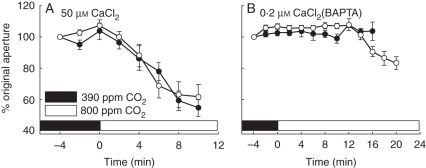Fig. 1.
CO2-induced stomatal closing is strongly inhibited under conditions that prevent [Ca2+]cyt elevations in guard cells. (A) Robust CO2-induced stomatal closing was observed in response to CO2 elevation with 50 µm Ca2+ added to the bathing medium (10 mm KCl, 7·5 mm iminodeactic acid, 10 mm MES, pH 6·2). Stomatal closing of individual stomata was tracked (see Box 1 for Methods) in response to elevations in the extracellular CO2 concentration from ambient (approx. 390 ppm) to 800 ppm (added at time = 0) with 50 µm Ca2+ in the bathing medium. (B) Buffering the extracellular free Ca2+ concentration to a low level of 200 nm using the Ca2+ chelator BAPTA strongly inhibited CO2-induced stomatal closing. Extracellular bathing media and free Ca2+ buffering to 200 nm was performed using identical solutions to those reported in Siegel et al. (2009). Experiments were conducted on 4- to 5-week-old plants according to the protocols described in (Siegel et al., 2009). CO2-induced stomatal closing experiments were performed under identical Ca2+ solutions to those published for ABA-induced stomatal closing experiments with 200 nm free Ca2+ or 50 µM Ca2+ in the bath medium (Siegel et al., 2009). Two independent experiments are shown for each condition (open and closed symbols); errors are presented as ± s.e. of the mean, n = 30.

